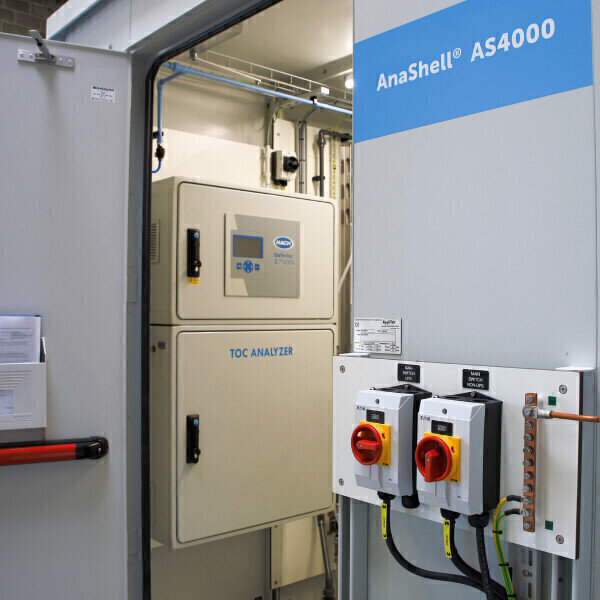Major airports invest in advanced wastewater monitors
Major airports invest in advanced wastewater monitors International Environmental Technology


Airport Run-off Monitoring with Hach BioTector Analyser

Airport run-off and effluent can be challenging to monitor, but the Hach® BioTector analyser delivers reliable Total Organic Carbon (TOC) measurements across a wide range and in highly variable contamination levels. Continuous TOC data improves treatment, lowers costs, and ensures regulatory compliance.
Introduction
Even during normal operations, airports have the potential to generate elevated amounts of pollution. Spillage of kerosene or jet fuel, maintenance of aircraft and ground vehicles, exterior washing, tyre abrasion, and fueling operations can all lead to high levels of contamination in water runoff. In winter, aircraft de-icing chemicals can escalate the load of organic substances from 20 mg/L C to 240,000 mg/L C in minutes. This presents a significant challenge in the appropriate measurement, control and treatment of wastewater.
Sustainable Development Goals (SDGs)
To comply with environmental regulations, airports must carefully monitor stormwater runoff and surface water effluent to ensure that levels of contamination are acceptable before releasing the water into the environment. This aligns with the following SDGs:
- SDG 6: Clean Water and Sanitation
- SDG 9: Industry, Innovation and Infrastructure
- SDG 11: Sustainable Cities and Communities
- SDG 12: Responsible Consumption and Production
- SDG 13: Climate Action
- SDG 14: Life Below Water
- SDG 15: Life on Land
The Importance of TOC Analysis
TOC (Total Organic Carbon) analysis is the most cost-effective, accurate, and timely method for the measurement of organics in water. 24/7 monitoring offers operational savings through the controlled release of contaminated water to the wastewater treatment plant; helping to eliminate regulatory fines and optimize glycol recovery.
Hach BioTector B7000i TOC Analyser
Already proven at some of Europe’s leading airline hubs, the Hach® BioTector B7000i TOC analyser is the ideal measurement tool for airports and other challenging effluent monitoring applications. Crucially, the analyser is able to provide reliable and accurate measurements regardless of weather or sample conditions, and can be interfaced with airport networks; providing access to real-time data.
The BioTector’s powerful Two-Stage Advanced Oxidation (TSAO) process is designed for fast cycle times and accurate analysis with minimal maintenance. All parts of the analyser that come into contact with the sample are automatically cleaned during every measurement cycle, and without the need for an external cleaning agent. The analyser is able to measure both high and low TOC levels accurately without any carryover issues.
For airport applications, the Hach BioTector B7000i analyser incorporates three ranges to allow correct measurement of carbon concentration at the corresponding measuring ranges – the analyser is able to signal and switch between low and high ranges automatically without any issues.
Sample handling is also trouble-free with the BioTector; even in applications where wastewater has a high viscosity and contains glycol, grease, oils, salts, and particulates.
Key Benefits of the B7000i TOC Analyser
- Superior reliability – typically 99.86% uptime
- High dependability – unique two-stage advanced oxidation technology handles even challenging applications involving oils, greases, salts, sludge, and particulates
- Intelligent design – self-cleaning technology and oversized tubing prevents clogging and sample contamination
- Minimal maintenance – no calibration or service is required between the 6-month service interval
- Low cost of ownership – provides a quick payback with cost savings in waste reduction and optimized processes
Installation in AnaShell Shelter
With large areas of impermeable surfaces and extensive drainage and wastewater collection systems, there are many useful measuring points at airports. For remote locations, the TOC analyser can be installed inside a Hach AnaShell® shelter, which is a complete weather and corrosion resistant solution, capable of housing up to ten analysers. All instruments are pre-mounted and the entire shelter is tested prior to shipment for instant and sustainable operational reliability on site. With everything from a single source, including professional integration; reliability and ease of use are assured.
SDGs, Targets, and Indicators
| SDGs | Targets | Indicators |
|---|---|---|
| SDG 6: Clean Water and Sanitation | Target 6.3: Improve water quality by reducing pollution, eliminating dumping, and minimizing release of hazardous chemicals and materials | – Levels of contamination in stormwater runoff and surface water effluent – Total Organic Carbon (TOC) levels in water |
| SDG 9: Industry, Innovation, and Infrastructure | Target 9.4: Upgrade infrastructure and retrofit industries to make them sustainable, with increased resource-use efficiency and greater adoption of clean and environmentally sound technologies | – Use of Hach BioTector B7000i TOC analyser for efficient monitoring of airport wastewater – Integration of the analyser with airport networks for real-time data access |
| SDG 11: Sustainable Cities and Communities | Target 11.6: Reduce the adverse per capita environmental impact of cities, including by paying special attention to air quality and municipal and other waste management | – Reduction in pollution levels in airport wastewater through improved treatment – Lower costs and optimized processes in waste reduction |
1. Which SDGs are addressed or connected to the issues highlighted in the article?
SDG 6: Clean Water and Sanitation
The article discusses the challenge of monitoring airport runoff and effluent, which can lead to high levels of contamination in water. This is directly connected to SDG 6, which aims to ensure availability and sustainable management of water and sanitation for all.
SDG 9: Industry, Innovation, and Infrastructure
The article highlights the use of the Hach BioTector B7000i TOC analyser as an innovative and sustainable technology for monitoring airport wastewater. This aligns with SDG 9, which focuses on promoting sustainable industrialization and fostering innovation.
SDG 11: Sustainable Cities and Communities
The article mentions the need to comply with environmental regulations and improve treatment of wastewater to reduce pollution levels. This relates to SDG 11, which aims to make cities and human settlements inclusive, safe, resilient, and sustainable.
2. What specific targets under those SDGs can be identified based on the article’s content?
Target 6.3: Improve water quality by reducing pollution, eliminating dumping, and minimizing release of hazardous chemicals and materials
The article emphasizes the importance of monitoring stormwater runoff and surface water effluent to ensure acceptable levels of contamination before releasing the water into the environment. This aligns with Target 6.3, which focuses on improving water quality by reducing pollution.
Target 9.4: Upgrade infrastructure and retrofit industries to make them sustainable, with increased resource-use efficiency and greater adoption of clean and environmentally sound technologies
The article highlights the use of the Hach BioTector B7000i TOC analyser as an efficient and sustainable technology for monitoring airport wastewater. This aligns with Target 9.4, which aims to upgrade infrastructure and industries to make them more sustainable.
Target 11.6: Reduce the adverse per capita environmental impact of cities, including by paying special attention to air quality and municipal and other waste management
The article mentions the need to improve treatment of wastewater to reduce pollution levels and optimize processes, which contributes to reducing the adverse environmental impact of cities. This aligns with Target 11.6, which focuses on reducing the per capita environmental impact of cities.
3. Are there any indicators mentioned or implied in the article that can be used to measure progress towards the identified targets?
– Levels of contamination in stormwater runoff and surface water effluent: The article emphasizes the need to carefully monitor these levels to ensure compliance with environmental regulations and acceptable water quality standards.
– Total Organic Carbon (TOC) levels in water: The article highlights TOC analysis as the most cost-effective and accurate method for measuring organics in water. Monitoring TOC levels can help assess the pollution levels and effectiveness of wastewater treatment.
– Use of Hach BioTector B7000i TOC analyser for efficient monitoring of airport wastewater: The article promotes the use of this specific analyser as a reliable and accurate tool for measuring TOC levels in challenging effluent monitoring applications.
– Integration of the analyser with airport networks for real-time data access: The article mentions the ability of the analyser to be interfaced with airport networks, providing access to real-time data. This indicator reflects the adoption of innovative technologies for efficient monitoring and management of wastewater.
4. Table: SDGs, Targets, and Indicators
| SDGs | Targets | Indicators |
|---|---|---|
| SDG 6: Clean Water and Sanitation | Target 6.3: Improve water quality by reducing pollution, eliminating dumping, and minimizing release of hazardous chemicals and materials | – Levels of contamination in stormwater runoff and surface water effluent – Total Organic Carbon (TOC) levels in water |
| SDG 9: Industry, Innovation, and Infrastructure | Target 9.4: Upgrade infrastructure and retrofit industries to make them sustainable, with increased resource-use efficiency and greater adoption of clean and environmentally sound technologies | – Use of Hach BioTector B7000i TOC analyser for efficient monitoring of airport wastewater – Integration of the analyser with airport networks for real-time data access |
| SDG 11: Sustainable Cities and Communities | Target 11.6: Reduce the adverse per capita environmental impact of cities, including by paying special attention to air quality and municipal and other waste management | – Reduction in pollution levels in airport wastewater through improved treatment – Lower costs and optimized processes in waste reduction |
Behold! This splendid article springs forth from the wellspring of knowledge, shaped by a wondrous proprietary AI technology that delved into a vast ocean of data, illuminating the path towards the Sustainable Development Goals. Remember that all rights are reserved by SDG Investors LLC, empowering us to champion progress together.
Source: envirotech-online.com

Join us, as fellow seekers of change, on a transformative journey at https://sdgtalks.ai/welcome, where you can become a member and actively contribute to shaping a brighter future.







